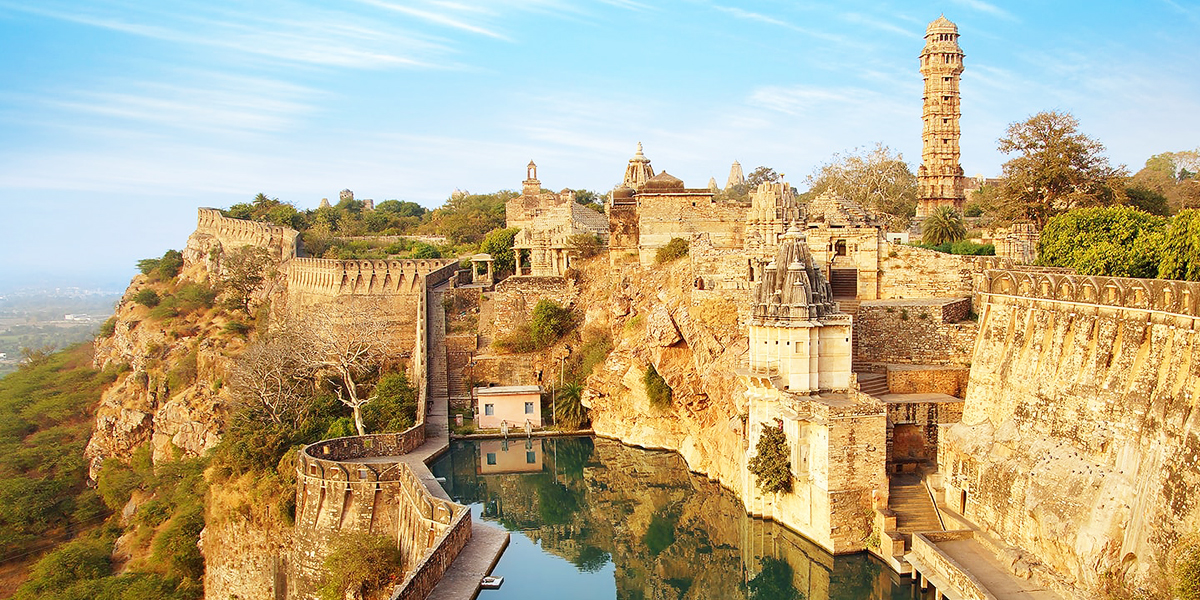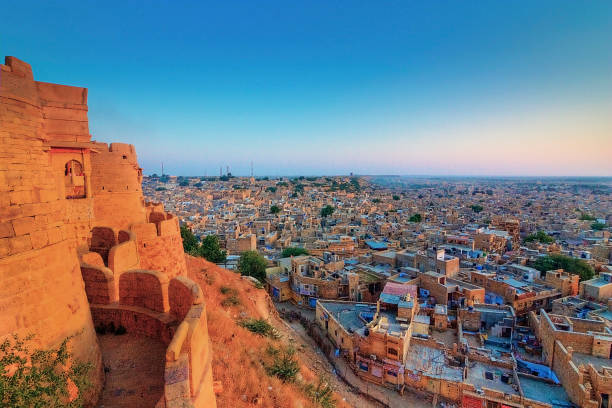Chittorgarh Fort
Chittorgarh Fort is regarded as the symbol of Rajput gallantry, resistance and valour. The fort is situated 175 kilometer to the east of Udaipur.

Chittorgarh Fort is reckoned among the most famous fort in India. Not only because of its gigantic structure and oldest fort in Rajasthan but also for its stands throughout many generations. Chittorgarh Fort is considered as unbreakable and immiscible.
Location: Chittorgarh, Rajasthan
Built By: Chitrangada Mori
Occupants: Mauryas of Chittor, Guhilas of Medapata, Sisodias of Mewar
Area: 691.9 acres
Current Status: The fort has been declared as UNESCO World Heritage Site
Visiting Time: 9:45AM - 6:30PM
Important Structures: Vijay Stambh, Kirti Stambh, Gaumukh Reservoir, Rana Kumbha Palace, Padmini Palace, Meera Mandir, Kalikamata Mandir, Fateh Prakash Palace, Jain Mandir
Seven Gates of the Fort: Padan Pol, Bhairon Pol, Hanuman Pol, Jorla Pol, Ganesh Pol, Laxman Pol, Ram Pol
Chittorgarh Fort is regarded as the symbol of Rajput gallantry, resistance and valour. The fort is situated 175 kilometer to the east of Udaipur and is believed to be named after the person who built it, Chitrangada Mori. The renowned Chittorgarh fort, which is one of the largest in India, is situated on a 180 meter high hill that rises from the banks of river Berach. The fort is known for its seven gates namely Padan Gate, Ganesh Gate, Hanuman Gate, Bhairon Gate, Jodla Gate, Lakshman Gate and the main gate which is named after Lord Ram. The Chittorgarh fort houses many palaces, like the Rana Kumbha Palace, the Fateh Prakash Palace, the Tower of Victory and Rani Padmini's Palace. All these structures are significant for their Rajput architectural features. There are also many temples within the fort. A huge complex of Jain temples are a major attraction. Chittorgarh fort, along with other hill forts of Rajasthan was declared as UNESCO World Heritage Site in 2013.
The fort comprises of four palaces, nineteen temples, twenty water bodies and four memorials.
Fateh Prakash Palace is a modern style palace which was built by Maharana Fateh Singh. Located in the Chittorgarh Fort, the palace is now transformed into a government museum, and has a wide range of beautiful sculptures, ancient weapons such as daggers, knives, axes, helmets, shields and uniform of soldiers. This spectacular museum is also home to a Ganesh idol, a fountain and frescos.
At Mohan Magri, Satbis Deori is a beautiful temple, where Jains come for worship. The fort of Chittorgarh has 6 Jain temples with beautiful intricate carvings. Amongst the many temples, Bhagwan Adinatha with 52 devkulikas is the largest.
The intense history of Chittorgarh fort will definitely set the pulse racing for many tourists. According to legends, the fort was built by Chitrangada Maurya and is located 175 kilometers to the east of Udaipur. The fort signifies the courage and sacrifice of the Rajput. However, there are other stories revolving around the fort, one says that Bhima, one of the Pandavas, with all his accumulated strength hit the ground and from it a huge reservoir came into being. The water body created by Bhima is called Bhimlat Kund. The Chittorgarh Fort also popularly known as Water Fort and is home to 22 water bodies, palaces, towers and temples spread over 700 acres.
The fort was captured numerous times; the first one to lay his hands on the fort was Bappa Rawal of the Guhila dynasty, who defeated the Moris to capture the majestic fort. Another historical story suggests that the fort was under the Arabs and they were defeated by Bappa Rawal. The third story concludes that Bappa Rawal received the fort as dowry by the Moris after he got married to one of the princesses from their kingdom. The fort also witnessed the most epic battle in Indian history of Alauddin Khilji and King Ratnasimha that lasted for almost eight months. The Delhi Sultanate ruler Alauddin Khilji was brutal in his intent and massacred 30,000 Hindus after capturing the fort. He was smitten by the ravishing beauty Princess Padmini, who was married to King Ratnasimha. This evil motive of his led to the self-immolation (jauhar) of Queen Padmini, who refused to give in to his demands. His ego was shattered after he witnessed the sacrifice of Queen Padmini along with other women, however after his death; the fort was passed on to his son Khizr Khan.
The Rajputs were dominant in their endeavour to capture the fort and ultimately succeeded after Khizr Khan had no option but to surrender to Sonigra chief Maldeva. For duration of seven years, the fort was under his control, but Hammir Singh of the Mewar Dynasty intervened and captured the fort. The Mewar Dynasty cherished every bit of ruling the fort and built an indomitable military under the reign of Rana Kumbha. But Rana Kumbha couldn’t sustain for long as his own son killed him to take control of it. After the crumbling of the Mewar Dynasty, Bahadur Shah rose to fame and captured the fort in 1535.
The year 1567 saw the rise of Emperor Akbar who wanted to take control of the whole India and became obsessed to capture the Chittorgarh Fort. Once his intention was set on conquering the fort, there was no looking back. Emperor Akbar defeated Rana Uday Singh II of the Mewar Dynasty in a battle that continued several months.
Winters (October to March) are the best time to visit Chittorgarh Fort.
